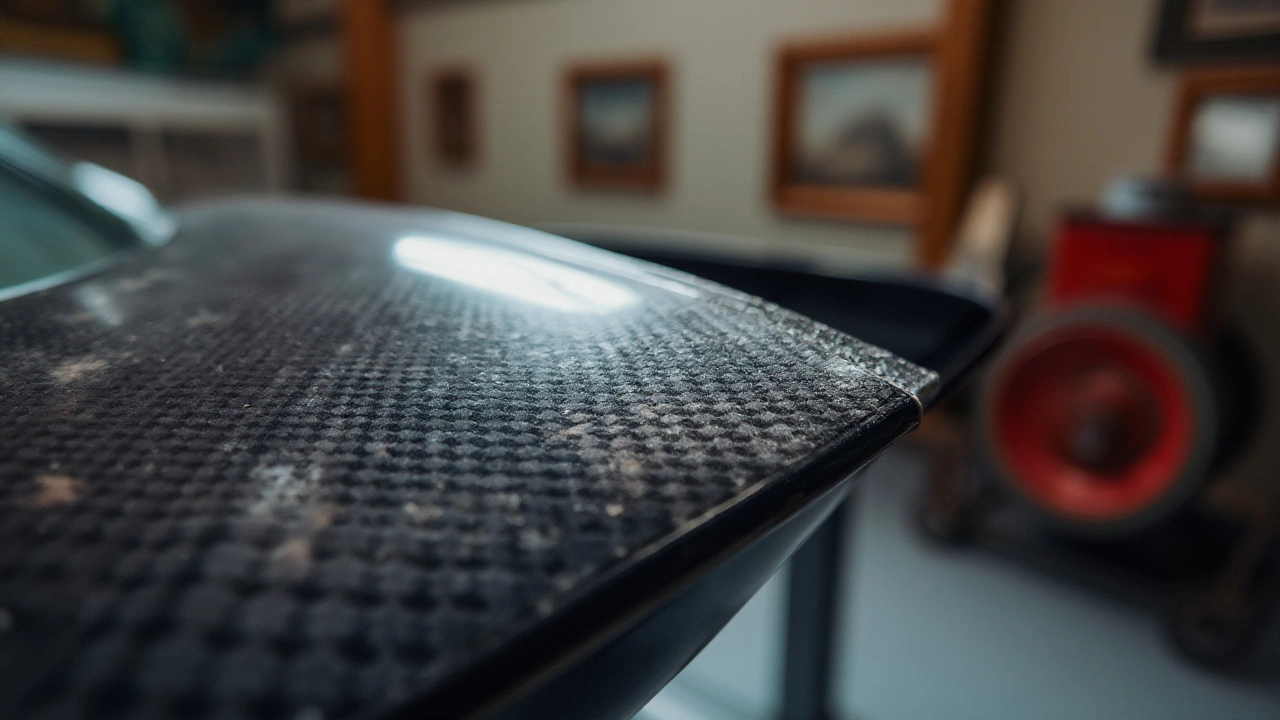Carbon fiber spoilers often catch the eye with their sleek design and promise of enhancing performance. Despite their popularity among car enthusiasts, it's essential to weigh the potential downsides before making a decision. These spoilers are not just about style; they play a critical role in the dynamics of how a vehicle moves.
Knowing both the advantages and the drawbacks can help in making an informed choice. Whether it's about aerodynamics, cost, or practical use, understanding each component is crucial. Let's dive into what makes carbon fiber spoilers a double-edged sword for any vehicle.
- Understanding Carbon Fiber Spoilers
- Potential Disadvantages
- Impact on Vehicle Handling
- Making the Right Choice
Understanding Carbon Fiber Spoilers
The allure of carbon fiber lies in its remarkable combination of strength and lightness, a dream for any automotive enthusiast. This material is born from an intense process where carbon atoms are bonded together to form a strong lattice. Initially popularized in aerospace applications, carbon fiber now finds itself intensely integrated into the automotive world, especially in the form of car spoilers. These components are not just tucked-in accessories for show; they serve an actual purpose by managing airflow to enhance a vehicle's dynamics. Essentially, a spoiler alters the air movement over a vehicle to reduce lift and drag, which can keep the car steady at speed.
Carbon fiber spoilers have become almost synonymous with performance cars, not least because they significantly impact car aerodynamics without adding extra weight. This celebrated lightness means reduced fuel consumption, making them an attractive option for those keen on pushing for higher speeds or better mileage. Yet, despite the advantages, not all that glitters is gold. They can be incredibly costly relative to their fiberglass counterparts, a point that sometimes makes them less viable for all enthusiasts. As such, these spoilers target a niche audience that can afford this performance-driven luxury.
The Craftsmanship of Carbon Fiber
Creating a carbon fiber spoiler is an art form that involves intricate weaving of carbon fibers, followed by setting these fibers in resin to hold their shape. This process can take numerous iterations to perfect, resulting in a spoiler that not only accentuates a vehicle's aesthetics but also stands the test of high-speed conditions. The role of carbon fiber is multifaceted. Its influence extends beyond just performance—it's about attitude, about letting others know the car means business.
Frequent users stress their effectiveness. "The real magic happens at the race track," noted Marcus Carlsson, a seasoned race-ready restorer.
"A well-placed carbon fiber spoiler can transform how the car grips into corners, and significantly enhances stability,"he asserts. The dynamics of these spoilers vary depending on the type of vehicle and driver preferences, underscoring the importance of customization.
Are They Worth It?
Despite their widespread adoption in high-performance vehicles, carbon fiber spoilers aren't without pitfalls. For starters, installation is crucial. A poorly-installed spoiler won't just fail to deliver its touted benefits—it can actually ruin a car's handling. Plus, carbon fiber, though resilient, can be prone to damage from aggressive impacts or environmental elements like prolonged sun exposure. This then raises the question about maintenance, which isn't exactly straightforward. While cleaning might sound simple, it requires care to avoid scratching or weakening the composite. Therefore, when considering a carbon fiber spoiler, weigh both the money spent and the commitment to upkeeping them in prime condition.
Stats on Carbon Fiber Usage
Carbon fiber has seen a 10% year-on-year increase in utilization across the automotive industry, making it clear that this material is more than a fleeting trend. Yet, the comparison of costs can't be ignored. To shed light on this, consider an illustrative scenario:
| Material | Average Cost (USD) |
|---|---|
| Carbon Fiber | 1,500 - 3,000 |
| Fiberglass | 300 - 500 |
Given the investment required, it's understandable why people may hesitate. But for those who seek top-notch performance and can justify the cost, carbon fiber could well be an essential upgrade. Understanding these factors could be the key to knowing if your vehicle truly needs this high-impact, lightweight addition.

Potential Disadvantages
Carbon fiber spoilers, while desirable for their sleek appearance and performance-enhancing features, do not come without their cons. One significant downside is the cost. These spoilers are considerably more expensive than those made from traditional materials like fiberglass or ABS plastic. The production process for carbon fiber involves intricate weaving of fibers, cured with resin under high pressure and temperature, making production both time-consuming and costly. This high cost can deter many average car owners who might not want to invest in such an expensive accessory for their vehicle tails.
Alongside cost considerations, carbon fiber spoilers are also prone to damage. Despite being known for their strength-to-weight ratio, carbon fiber can suffer from brittleness under certain conditions. A minor impact that might leave a fiberglass spoiler with a mere scratch could crack a carbon fiber one. This susceptibility to cracking or structural damage in even curb contact means careful handling is crucial; otherwise, repair or replacement can further compound the expenses. This delicate nature poses a contrast to the sturdy appearance they convey, leaving some to question their practicality.
Performance-wise, installation errors can negatively impact a vehicle's handling. If a spoiler isn't installed correctly or is mismatched to the car's actual driving requirements, it might create unnecessary drag instead of enhancing downforce, thereby reducing the performance rather than increasing it. This is particularly the case for those who install spoilers on vehicles not frequently exceeding highway speeds, where the aerodynamic benefits are negligible. Choosing the right type of spoiler and professional installation are paramount to ensure benefits without the pitfalls of poor handling.
Weather Factors and Longevity
External factors like weather also play a crucial role in the longevity of a carbon fiber spoiler. UV exposure can degrade the outer coating over time, causing fading, color changes, and the integrity of the material to be compromised. While some manufacturers apply UV-resistant coatings to mitigate this issue, no solution is entirely foolproof against long-term exposure. This becomes an additional maintenance concern and potential extra cost for owners constantly under the sun's relentless heat or other harsh climatic conditions.
As George Thompson, a renowned automotive engineer, once noted, "The choice to use carbon fiber parts, including spoilers, requires balancing excitement with realism. Their advantages are undeniable, but acknowledging their limitations is crucial for any responsible vehicle owner."
In conclusion, while carbon fiber is a high-performance material, these spoilers come with distinct disadvantages that require careful consideration. From the inherent vulnerability to damage, cost implications, to potential negative impacts on handling, these factors all weigh heavily when deciding on such an automotive upgrade. While the allure of a carbon fiber spoiler remains strong, its purchase is not without its complexities and considerations.

Impact on Vehicle Handling
The allure of carbon fiber spoilers isn't just about making your vehicle look sleek and sporty; it's largely about their promise to enhance your car's handling by improving aerodynamics. Yet, it's important to delve deeper into how these additions actually affect the vehicle's dynamics. A spoiler works by disrupting airflow over the car, generating downforce. This downforce is designed to keep the car planted on the road, especially at high speeds. But the key to harnessing this benefit often lies in the specifics of design and installation. If not correctly adjusted, a spoiler can actually upset the vehicle’s balance, leading to unpredictable handling characteristics.
The effects of these high-performance components are not uniform across all vehicles. While some cars might experience improved gripping capabilities, others might suffer from increased drag, which can reduce fuel efficiency. This is especially true if the spoiler design wasn't tailored to the car's existing aerodynamics. For instance, a spoiler that suits a high-powered sports car might not be the best fit for a compact sedan. Therefore, understanding the aerodynamic needs specific to your vehicle is critical before opting for a spoiler addition. This complex interplay highlights why it’s not just about attaching a spoiler and expecting miracles.
"The balance between aerodynamics and performance is a tightrope walk every car enthusiast must learn," notes Jesse Alexander, a renowned automotive engineer. "While car spoilers can help in certain scenarios, misalignments or design mismatches can lead to more harm than good."
There is also a crucial discussion to be had about weight distribution. Despite carbon fiber's reputation for being lightweight, every ounce added to the car affects its dynamics. The placement of a carbon fiber spoiler can shift this balance. Combining this with an already misaligned suspension can cause understeer or oversteer, depending on the driving conditions. As a result, enthusiasts should be prepared for potential changes in how their car responds to directional inputs. A professional setup and regular alignment checks become crucial with spoilers dedicated to performance modifications.
The technology in performance parts like carbon fiber spoilers is continuously evolving, and so too are the arguments surrounding their utility. It's pertinent to recognize that while they might improve downforce for some, they could equally complicate handling if not matched carefully to the vehicle’s design and intended usage. Thus, the journey to modifying a vehicle with spoilers should always come with ample research and consideration of these dynamic impacts.

Making the Right Choice
When it comes to enhancing your vehicle with a carbon fiber spoiler, making the right choice involves more than just picking the design that catches your eye. There is an array of considerations that delve into the specifics of your car's performance, your driving habits, and, of course, your budget. Carbon fiber is celebrated for its lightweight and high-strength characteristics, making it an adept material for managing aerodynamics and reducing weight. However, this doesn't automatically render it the optimal choice for every driver or every car model. Factors like the car's current aerodynamic features, its weight, and the intended use – whether for racing, daily driving, or show – must all be part of the decision-making process.
Assessing the financial aspects is also crucial. The initial investment in a carbon fiber spoiler can be steep due to the manufacturing process and the material's premium nature. This cost isn’t just a one-time expense; maintenance and potential repairs for such a high-end accessory can add up over time. Trustworthy sources such as Car and Driver often highlight that while carbon fiber provides many performance perks, it's essential to weigh these against the potential cost of upkeep. Also significant is where and how you drive. For instance, city driving with frequent stop-and-go traffic might not exploit the aerodynamic benefits as much as highway driving. Thus, aligning your purchase with your typical driving conditions is another critical factor.
“Carbon fiber may offer aesthetics and dividends in performance, but it also invites considerations of durability and expense,” notes auto expert Chris Johnson.
Next, let’s talk about vehicle aerodynamics. Installing a carbon fiber spoiler can considerably refine vehicular control at higher speeds by altering airflow. However, this modification isn’t a magic bullet. It demands a comprehensive understanding of how alterations impact your vehicle's natural balance. Incorrect installation or using a spoiler not designed for your specific model can lead to decreased efficiency or even stability issues. That's why consulting with a professional before adding any performance part is advisable. Experienced tuners or mechanics often possess insights into specific car models and can provide guidance on the best fit and installation procedures to ensure you maximize the benefits without compromising safety.
Lastly, consider the performance parts ecosystem holistically. A spoiler might be your starting point, but it's rarely a standalone solution. Each part of a vehicle's exterior interacts with others, from the hood to the undercarriage, potentially requiring complementary installs for full effect. Sometimes, adding a spoiler necessitates adjustments or enhancements in other parts of the vehicle to maintain aerodynamic balance. It's a synergistic approach, often recommended by automotive designers, who note that harmonizing elements can lead to the best performance outcomes. To summarize, being informed and strategic about your choices not only brings the anticipated benefits but also elevates your driving experience.






